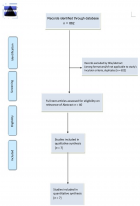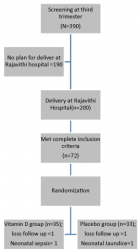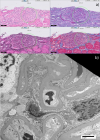Abstract
Research Article
Assessment of lipid and hematological profile among blood donors in European Gaza Hospital, Palestine
Ahmad M Tabash*, Wesam M Afana, Abdrabbou M Elregeb, Sameer Abu Eid and Ayman M Abu Mustafa
Published: 16 July, 2019 | Volume 4 - Issue 2 | Pages: 073-079
Background: There is an important shortage of blood in the greatest blood banks worldwide to meet up with requirements for numerous medical interventions. Limited studies have associated regular blood donation to the lowering of lipid function parameters. Assessing the lipid function is a classical method of evaluating an individual’s risk for coronary heart disease.
Objective: The general goal of the study is to determine lipid and hematological profile among blood donors in European Gaza Hospital, Palestine.
Materials and Methods: This study was a case-control study that involved 120 male, 40 of whom were regular blood donors (study group), 40 first time donors and 40 non- donors (control group) aged between 18-60 years. A volume of 5ml venous blood was drawn from each fasting participant into a dry biochemistry screw-capped tube. This was allowed to clot and the serum was used to determine total cholesterol (TC), triglycerides, High-density lipoprotein cholesterol (HDL-C), Low-density lipoprotein cholesterol (HDL-C), while HDL-C/LDL-C and TC/LDL ratio were calculated by using the following formula. Anthropometric parameters (weight, height) of donors were measured using standard protocol. The height (in meter), weight (in kilogram) were used to calculate the body mass index (BMI) using the following formula. BMI= weight (kg)/ (height in meter)² and blood was collected from each participant in EDTA (for hematocrit, ESR). Three groups were matched for age and BMI. Data were analyzed using SPSS version 23. Chi-square (χ²) was used to compare the relationship between categorical variables, ANOVA was used to measure the difference between means. Data were summarized using tables, pie charts, histograms. A P-value < 0.05 was considered to be statistically significant for all tests conducted.
Results: The mean total cholesterol (169±10.85 mg/dl), triglycerides (116±9.73 mg/dl), HDL (54±2.5 mg/dl ), LDL (92±11.4mg/dl), LDL/HDL ratio (1.73±0.25) and TC/HDL ratio (3.16±0.26) were lower in the regular blood donors than the first time donors(198±10.13, 179±5.82, 42.33±1.6, 120±11.2, 2.85±0.36, 4.7±0.40) and non- donors (202±10.19, 180±12.68, 41.75±1.4, 125±11.7, 2.99±0.33, 4.86±0.32) respectively and statistically significant (P < 0.05).The mean ESR (6.63±0.87mm/hr) was lower statistically significant in the regular blood donors than the first time donors (7.40±1.17) and non- donors (7.60±1.48) respectively (P < 0.05). The mean HCT (42.98±0.86%) was lower statistically significant in the regular blood donors than the first time donors (44.63±0.90) and non- donors (44.75±0.74, P < 0.05).
Conclusion: Regular donors have reduced risk of developing coronary heart disease as reflected by the low total cholesterol, triglycerides, LDL-c, LDL-c/HDL-c ratio, TC/HDL-c ratio and HCT and high HDL. BMI in regular donor was less than the donor for the first time and did not donate, but did not reach the statistical significance. Also in our study regular donors have reduced risk of developing inflammation as reflected by low ESR.
Read Full Article HTML DOI: 10.29328/journal.jccm.1001043 Cite this Article Read Full Article PDF
Keywords:
Lipid and hematological profile; Blood donors; European gaza hospital; Palestine
References
- World Health Organization (2014 ). Blood Safety and Availability, WHO Fact Sheet No. 279. Geneva: World Health Organization.
- World Health Organization (2017). Regional status report on blood safety and availability 2016 (No. WHO-EM/LAB/392/E). World Health Organization. Regional Office for the Eastern Mediterranean.
- Shidam, U. G., Lakshminarayanan, S., Saurabh, S., & Roy, G. (2015). Knowledge and attitude regarding blood donation in rural Puducherry, India. Natl J Community Med, 6(1), 64-68
- Faludi AA, Izar MCO, Saraiva JFK, Chacra APM, Bianco HT, et al. Atualização da diretriz brasileira de dislipidemias e prevenção da aterosclerose–2017. Arq Bras Cardiol. 2017; 109: 1-76. PubMed: https://www.ncbi.nlm.nih.gov/pubmed/28813069
- Medeiros Y, Pinheiro L, and Rodrigues P. Analysis on the lipid profile of adolescents from a municipality of sertao paraibano. Temas em Saúde. 2016; 16: 45-48.
- van Jaarsveld H, Pool GF. Beneficial effects of blood donation on high density lipoprotein concentration and the oxidative potential of low density lipoprotein. Atherosclerosis. 2002; 161: 395-402. PubMed: https://www.ncbi.nlm.nih.gov/pubmed/11888523
- Fallara J. Association Between the Body Mass Index and School Attendance Among K-3rd Public School Children. 2018.
- Tamariz LJ, Young JH, Pankow JS, Yeh HC, Schmidt MI, et al. Blood viscosity and hematocrit as risk factors for type 2 diabetes mellitus: the atherosclerosis risk in communities (ARIC) study. Am J Epidemiol. 2008; 168: 1153-1160. PubMed: https://www.ncbi.nlm.nih.gov/pubmed/18931370
- Felix CE, Ogodo ND and Ngozi AA. Evaluation of body mass index, hematocrit, erythrocyte sedimentation rate and total protein in voluntary and commercial blood donors in Nigeria: Advocating for simultaneous screening for nutritional status. Int J Blood Transfus Immunohematol. 2017; 7: 26-32.
- Heymann MA, Payne BD, Hoffman JI and Rudolph AM. Blood flow measurements with radionuclide-labeled particles. Progress in cardiovascular diseases. 1977; 20: 55-79.
- Bakker AJ and Mücke M. Gammopathy interference in clinical chemistry assays: mechanisms, detection and prevention. Clin Chem Lab Med. 2007; 45: 1240-1243. PubMed: https://www.ncbi.nlm.nih.gov/pubmed/17635066
- Young DS. Effects of drugs on clinical laboratory tests. AACC press. 2000.
- Millán J, Pintó X, Muñoz A, Zúñiga M, Rubiés-Prat J, et al. Lipoprotein ratios: physiological significance and clinical usefulness in cardiovascular prevention. Vasc Health Risk Manag. 2009; 5: 757-765. PubMed: https://www.ncbi.nlm.nih.gov/pubmed/19774217
- Girija, P. L. (2008). Anemia among women and children of India. Anc Sci Life. 2008; 28: 33. PubMed: https://www.ncbi.nlm.nih.gov/pmc/articles/PMC3336343/
- Bentley ME, Griffiths PL. (2003). The burden of anemia among women in India. Eur J Clin Nutr. 57: 52-60.
- EI Uche, A Adediran, OD Damulak, TA Adeyemo, AA Akinbami, et al. Lipid profile of regular blood donors. J Blood Med. 2013; 4: 39-42. PubMed: https://www.ncbi.nlm.nih.gov/pmc/articles/PMC3663474/
- Clement ANJ, Vincent VSV, Shey ND, Afoni BE and Marcelin NN. (2017). A Cross-Sectional Study on the Evaluation of the Lipid Profile of Regular Blood Donors in the Buea Regional Hospital, Cameroon. Cardiology and Cardiovascular Research. 2017; 1: 76-83.
- RA Wiklund, HD Stein and SH Rosenbaum. Activities of daily living and cardiovascular complications following elective, noncardiac surgery. Yale J Biol Med. 2001; 74: 75-87. PubMed: https://www.ncbi.nlm.nih.gov/pmc/articles/PMC2588693/
- Bharadwaj R. A study of lipid profiles among male voluntary blood donors in Chennai city. Indian J Community Med 2005; 30: 16-17.
- Panagiotakos DB and Toutouzas PK. Importance of LDL/HDL cholesterol ratio as a predictor for coronary heart disease events in patients with heterozygous familial hypercholesterolaemia: a 15-year follow-up (1987-2002). Current medical research and opinion. 2003; 19: 89-94.
- Adediran A, Adeyemo TA and Akanmu AS. Lipid profiles of regular blood donor. Journal of blood medicine. 2013; 4: 39-42.
- Getta HA, Ahmad HA, Rahman HS, Ahmed GA and Abdullah R. Medical and laboratory assessment for regular blood donors in sulaimani Blood Bank, Iraq. Patient preference and adherence 2018; 12: 939-944. PubMed: https://www.ncbi.nlm.nih.gov/pmc/articles/PMC5987750/
- Masuka TJ, Muswe R, Marange P and Zhou DT. Coronary Heart Disease Risk Profiles in Blood Donors at the National Blood Services. Zimbabwe Sch Bull. 2017; 3: 469-471.
- Ascherio A, Rimm EB, Giovannucci E, Willett WC and Stampfer MJ. Blood donations and risk of coronary heart disease in men. Circulation. 2001; 103: 52-57. PubMed: https://www.ncbi.nlm.nih.gov/pubmed/11136685
- Kamhieh-Milz S, Kamhieh-Milz J, Tauchmann Y, Ostermann T, Shah Y, et al. Regular blood donation may help in the management of hypertension: an observational study on 292 blood donors. Transfusion. 2016; 56: 637-644. PubMed: https://www.ncbi.nlm.nih.gov/pubmed/26643612
- Siemons L, Ten Klooster PM, Vonkeman HE, van Riel PL, Glas CA, et al. How age and sex affect the erythrocyte sedimentation rate and C-reactive protein in early rheumatoid arthritis. BMC Musculoskelet Disord. 2014; 15: 368. PubMed: https://www.ncbi.nlm.nih.gov/pubmed/25373740
- Brooks A C, Guillaumin J, Cooper ES and Couto CG (2014). Effects of hematocrit and red blood cell-independent viscosity on canine thromboelastographic tracings. Transfusion. 2014; 54: 727-734. PubMed: https://www.ncbi.nlm.nih.gov/pubmed/23901836
- Nemeth N, Alexy T, Furka A, Baskurt OK, Meiselman HJ, et al. Inter-species differences in hematocrit to blood viscosity ratio. Biorheology. 2009; 46: 155-165. PubMed: https://www.ncbi.nlm.nih.gov/pubmed/19458418
Figures:
Similar Articles
-
Assessment of lipid and hematological profile among blood donors in European Gaza Hospital, PalestineAhmad M Tabash*,Wesam M Afana,Abdrabbou M Elregeb,Sameer Abu Eid,Ayman M Abu Mustafa. Assessment of lipid and hematological profile among blood donors in European Gaza Hospital, Palestine. . 2019 doi: 10.29328/journal.jccm.1001043; 4: 073-079
-
Acute ischemic stroke for alteplase or medical care alone or intervention with/without alteplase in Palestine (AIS-AMI Palestine)Mohammed Habib*. Acute ischemic stroke for alteplase or medical care alone or intervention with/without alteplase in Palestine (AIS-AMI Palestine). . 2022 doi: 10.29328/journal.jccm.1001140; 7: 093-097
Recently Viewed
-
Genetic variability in the susceptibility of immature peach fruit to Monilinia laxa is associated with surface conductance but not stomatal densityLeandro Oliveira Lino,Carole Confolent,Véronique Signoret,Michel Génard,Bénédicte Quilot-Turion*. Genetic variability in the susceptibility of immature peach fruit to Monilinia laxa is associated with surface conductance but not stomatal density. J Plant Sci Phytopathol. 2022: doi: 10.29328/journal.jpsp.1001081; 6: 091-100
-
Recurrent Pancreatitis Associated with CFTR Heterozygous MutationTuğçe Şevval Yıldız*,Şeyma Şenocak. Recurrent Pancreatitis Associated with CFTR Heterozygous Mutation. Arch Case Rep. 2025: doi: ; 9: 008-011
-
Medical mystery: Deposition of calcium oxalate and phosphate stones in soft tissuesAlessandro Capitanini*,Brunilda Xhaferi,Vincenzo Miniello,Ophelia Meniconi,Claudia Zullo,Claudia Mannucci,Dritan Curi. Medical mystery: Deposition of calcium oxalate and phosphate stones in soft tissues. J Clini Nephrol. 2022: doi: 10.29328/journal.jcn.1001097; 6: 091-093
-
Inventorization and Exploration of Floral Diversity in Metropolitan Cities of India for Their Suitability in Floriculture of KashmirSheikh Abdul Shakoor*, Shoufar Farooq, Muskan Tareq, Iqra Rashid, Uzmeena Amin, Tehseen Manzoor, Nimra Mukhtar, Tabiya Altaf, Anjum Tehseen, Nazir Ahmad Malla. Inventorization and Exploration of Floral Diversity in Metropolitan Cities of India for Their Suitability in Floriculture of Kashmir. J Plant Sci Phytopathol. 2024: doi: 10.29328/journal.jpsp.1001144; 8: 121-130
-
Antifungal Efficacy of Panchgavya Formulations against Rhizoctonia solani: An Incitant of Rice Sheath BlightJR Pandya*, JV Patel. Antifungal Efficacy of Panchgavya Formulations against Rhizoctonia solani: An Incitant of Rice Sheath Blight. J Plant Sci Phytopathol. 2024: doi: 10.29328/journal.jpsp.1001143; 8: 118-120
Most Viewed
-
Evaluation of Biostimulants Based on Recovered Protein Hydrolysates from Animal By-products as Plant Growth EnhancersH Pérez-Aguilar*, M Lacruz-Asaro, F Arán-Ais. Evaluation of Biostimulants Based on Recovered Protein Hydrolysates from Animal By-products as Plant Growth Enhancers. J Plant Sci Phytopathol. 2023 doi: 10.29328/journal.jpsp.1001104; 7: 042-047
-
Sinonasal Myxoma Extending into the Orbit in a 4-Year Old: A Case PresentationJulian A Purrinos*, Ramzi Younis. Sinonasal Myxoma Extending into the Orbit in a 4-Year Old: A Case Presentation. Arch Case Rep. 2024 doi: 10.29328/journal.acr.1001099; 8: 075-077
-
Feasibility study of magnetic sensing for detecting single-neuron action potentialsDenis Tonini,Kai Wu,Renata Saha,Jian-Ping Wang*. Feasibility study of magnetic sensing for detecting single-neuron action potentials. Ann Biomed Sci Eng. 2022 doi: 10.29328/journal.abse.1001018; 6: 019-029
-
Pediatric Dysgerminoma: Unveiling a Rare Ovarian TumorFaten Limaiem*, Khalil Saffar, Ahmed Halouani. Pediatric Dysgerminoma: Unveiling a Rare Ovarian Tumor. Arch Case Rep. 2024 doi: 10.29328/journal.acr.1001087; 8: 010-013
-
Physical activity can change the physiological and psychological circumstances during COVID-19 pandemic: A narrative reviewKhashayar Maroufi*. Physical activity can change the physiological and psychological circumstances during COVID-19 pandemic: A narrative review. J Sports Med Ther. 2021 doi: 10.29328/journal.jsmt.1001051; 6: 001-007

HSPI: We're glad you're here. Please click "create a new Query" if you are a new visitor to our website and need further information from us.
If you are already a member of our network and need to keep track of any developments regarding a question you have already submitted, click "take me to my Query."






















































































































































